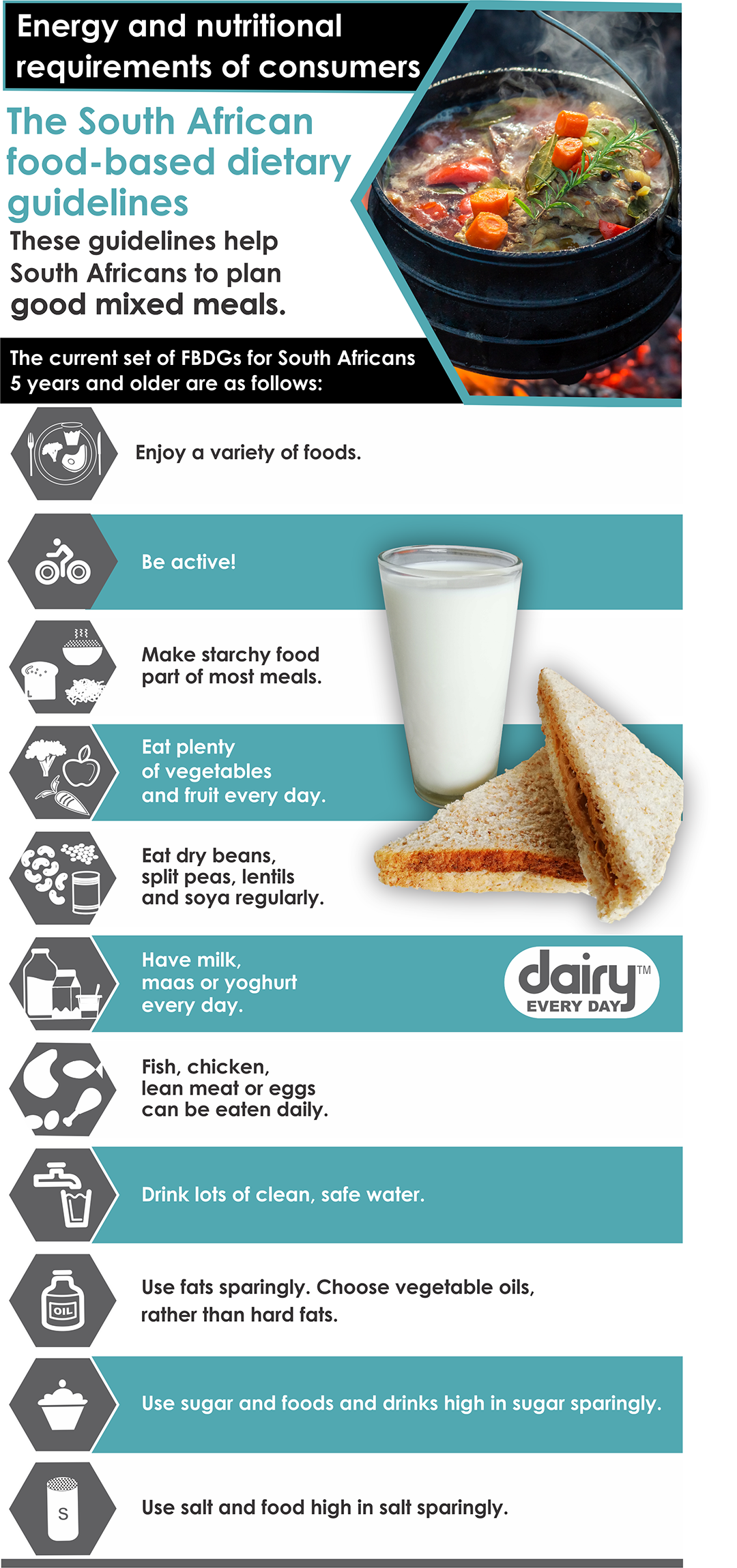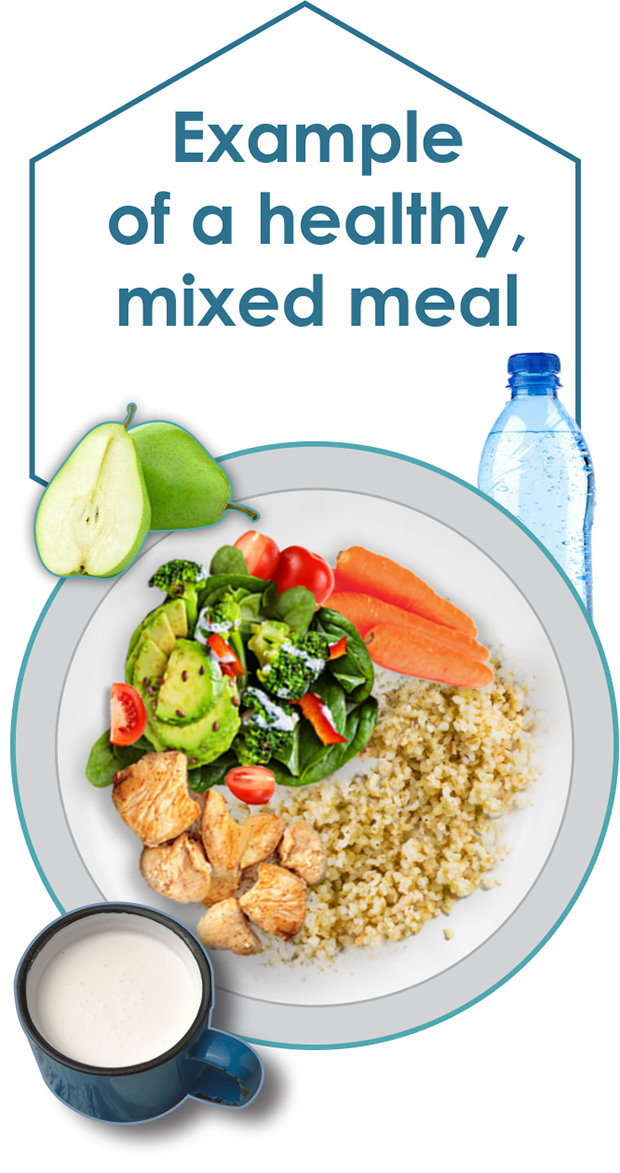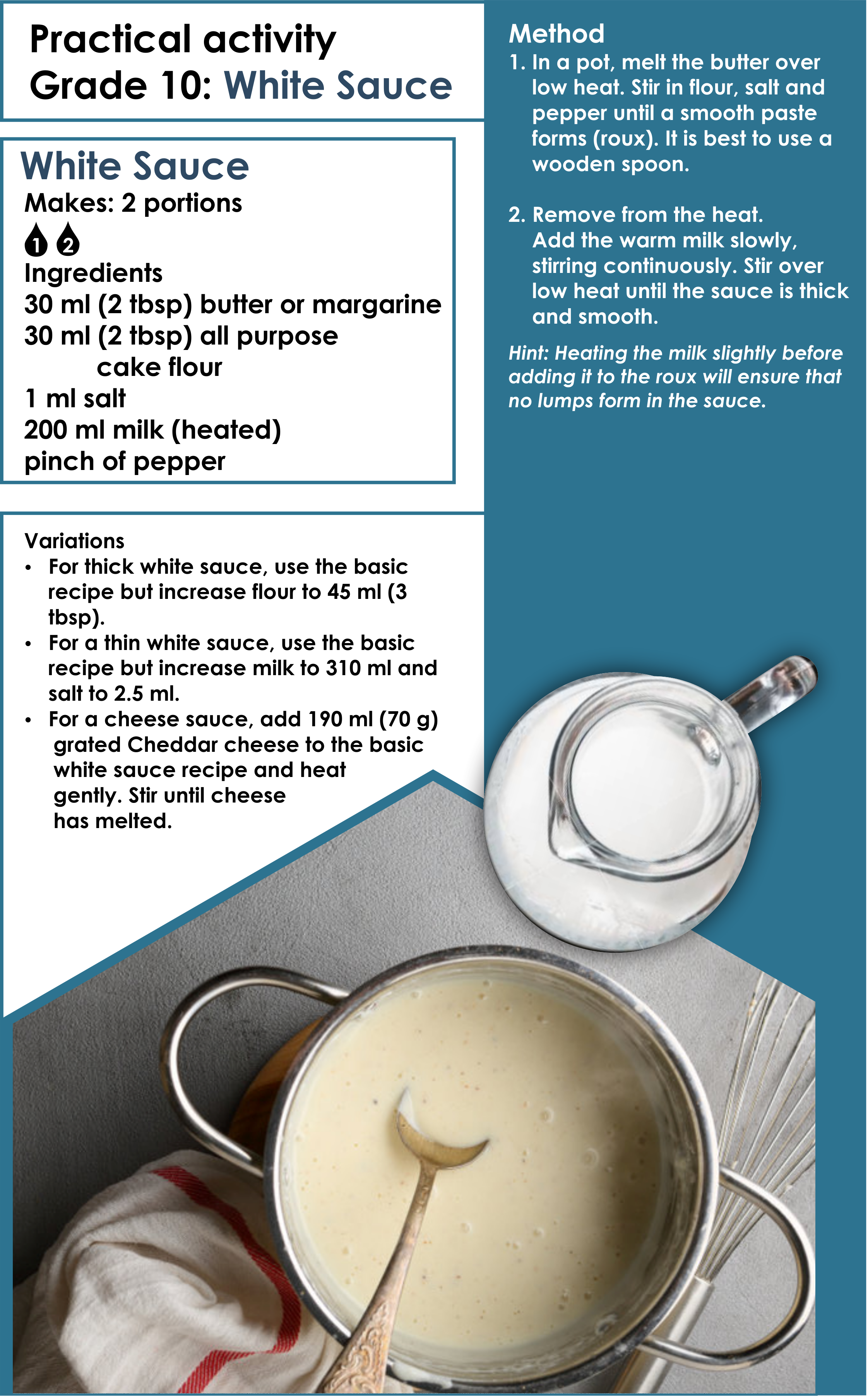
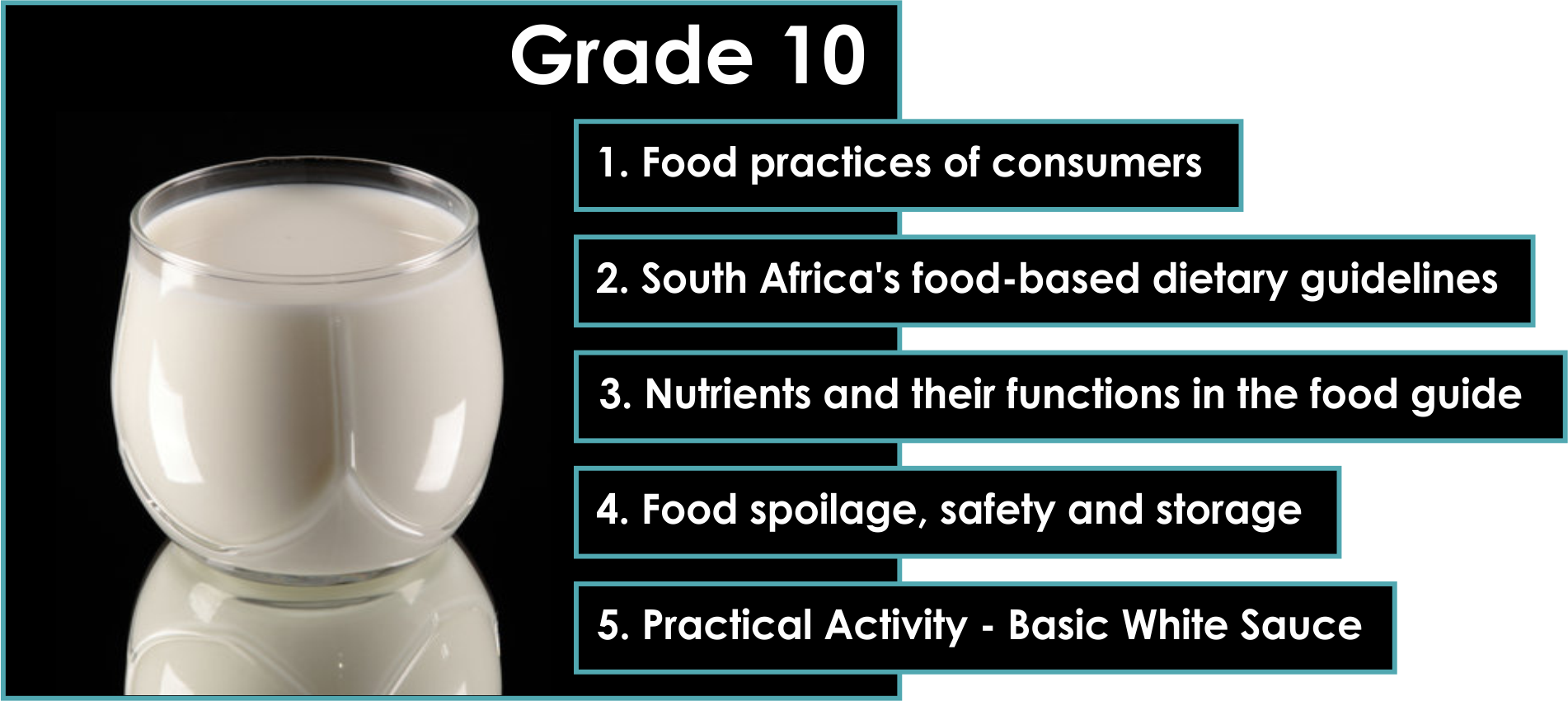
1. Food practices of consumers: Dairy is for everyone
1.1 Introduction
We choose things to eat and drink every day. These choices are influenced by a variety of factors, from our upbringing to the influence of the media. Milk and dairy have an important role in our daily diet, and there’s a dairy option to suit everyone’s needs and preferences.

1.2 Factors that influence food choices
Factors influencing food choices can be as diverse as culture, tradition, religion, age, income, level of physical activity and aesthetics. It is much more than just a preference of taste.
1.2.1 Food traditions
There are many different religions in South Africa. Food choices influenced by religious considerations depend on how strictly people follow their religious teachings.
- In Judaism, milk and dairy must be prepared according to kosher principles and may not be consumed together with meat.
- According to Islamic teachings, milk and dairy products must be halal. This means that the product may not contain any raw material or prohibited additives.
- Christian teachings do not mention any taboo foods.
Food choices also have a strong cultural element. Think of the nutrient-rich amasi enjoyed throughout South Africa. Amasi is a traditional fermented dairy drink. It has a thick, creamy texture and a distinct sour taste. It is traditionally consumed with starchy food such as pap or bread, or enjoyed on its own. Similarly, melktert and melkkos are favourite foods in many South African households.
1.2.2 Socio-economic conditions
Socio-economic factors refer to where people live, their level of education, job status, income category and general standing in society. These elements influence consumers’ food choices. In poor socio-economic conditions people often have nutritionally poorer diets, which may lead to malnutrition. A lack of knowledge may lead to people making unhealthy food choices and result in compromised health.
Milk is a good source of several important nutrients that are lacking in many South Africans’ diets. These include high-quality protein and minerals like calcium, zinc, potassium, magnesium and phosphorus as well as vitamins A, B12 and B2. How these nutrients interact in a given food structure – called the food matrix – determines their overall nutritional and health properties. Milk is a popular food choice across all socio-economic groups because it is:
- versatile – it is easy to store – milk can be bought fresh, as a long-life product or in powder form and can be combined with many other food groups
- readily available in formal and informal retail
- affordable and good value for money as it supplies many important nutrients in a single serving
1.2.3 Health conditions
Food allergies and intolerances can directly influence consumers’ food choices, as they can choose to avoid certain foods to prevent adverse reactions.
- A food allergy occurs when a specific protein of the food prompts the body to launch an undue immune response to ‘defend’ the body against the substance.
- A food intolerance occurs when the body cannot tolerate or absorb a specific compound in a food.
With regard to milk and dairy, both cow’s milk allergy (CMA) and lactose intolerance are recognised health conditions. Cow’s milk allergy is the body’s immune response to the proteins found in cow’s milk (30–35 g of protein per litre). Milk protein is made up of 25 different proteins, of which up to 20 have been identified as allergenic. Symptoms most commonly include skin reactions or gastrointestinal and respiratory problems. In the case of true milk allergy, the person has to avoid milk and dairy completely. However, it is important that the diagnosis of cow’s milk allergy should be clinically confirmed by a medical professional such as a doctor or dietitian, so that people do not unnecessarily exclude dairy from their diet. Cow’s milk allergy is most common in children, with an estimated incidence of 2–7.5% in the first year of life. Most people outgrow this allergy after childhood.
Lactose intolerance is not the same as milk allergy. Instead, it is a gastrointestinal disturbance that occurs because the body does not produce the enzyme (lactase) needed to break down lactose, the sugar naturally found in milk. Lactose consists of two sugar molecules – glucose and galactose – bound together. If the body does not produce enough of the enzyme lactase, the two sugar units cannot be separated and absorbed into the blood. The milk sugar then starts fermenting, which could lead to bloating, flatulence, loose stools and stomach cramps.
People who are lactose intolerant do not have to exclude dairy from their diet completely. In fact, there are several practical things people can do to help them tolerate lactose better, for example:
- Consume small amounts of dairy products at a time and space your intake throughout the day. Full-cream milk is tolerated better than low-fat or fat-free milk, because of the higher fat content.
- Using milk and dairy combined with other foods (e.g. having milk with cereal) will slow down the digestion of lactose and so help to ease discomfort.
- Cheddar, Gouda and Mozzarella cheese are generally tolerated well, because cheese contains negligible amounts of lactose.
- Yoghurt and amasi are generally well tolerated. Because they are fermented products, some of the lactose has already been broken down. In addition, yoghurt and amasi contain friendly bacterial cultures, which improve digestion and gut health.
- Choose lactose-free dairy products to get the same nutritional benefits as you would when using lactose-containing dairy.
1.2.4 Consumer trends
Popular ideas and product choices can affect consumers’ decisions about food. These trends can develop from discussions with our peers, what we see in the media and also our own interests. Some examples include the rising popularity of choosing plant-based diets over animal-derived foods such as meat and dairy.
Today, some consumers choose plant-based alternatives to milk. These choices are often influenced by people’s perceptions about the impact of animal-based diets on health, environmental sustainability and animal welfare. However, just because a product is called ‘milk’ or looks like milk does not mean it has the same nutritional properties ad health benefits as cow’s milk.
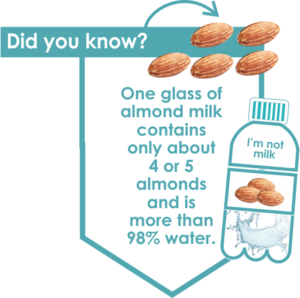
Plant-based beverages labelled as ‘milk’ have an inconsistent nutritional profile and lack the nutrients found naturally in milk. They are highly processed and are made by grinding up plant materials such as cereals (e.g. oats, rice, corn, spelt), legumes (e.g. soybeans, peanuts, cowpeas), seeds (e.g. sesame, flaxseed, hemp, sunflower) or nuts (almond, coconut, walnuts), and then mixing it with water, thickeners and stabilisers. This liquid is then further processed to produce a substance that looks like milk and mimics its use. Plant-based alternatives to milk are fortified with vitamins and minerals such as calcium and vitamin B12 and most often contains added sucrose sugar.
To make informed choices, consumers should consider factual information. For example, it takes about 17 times more water to produce a litre of almond milk than cow’s milk. Growing crops from which plant-based milk alternatives are produced may also involve considerable use of fertilisers or pesticides, and products that are not produced locally may have a large carbon footprint because of their being transported over long distances. If such factors are not considered, the perceived environmental benefit of choosing plant-based beverages over cow’s milk may be skewed.
Overly processed plant-based products can never replace a naturally nutrient-rich whole food such as cow’s milk. Consumers who choose an entirely plant-based diet, such as vegetarians and vegans, should plan their diets carefully to ensure that they do not miss out on important nutrients, which may occur naturally in animal-based foods. It may be necessary for these consumers take supplements for some vitamins and minerals, such as iron and vitamin B12.
1.2.5 Lifestyle choices
Consumers have varying nutritional needs because of their specific level of physical activity or lifestyle. For example, the nutritional needs of an athlete will be different from those of a business executive who often travels for work or the elderly, whose lifestyle is generally slower-paced and physically less active.
Good nutrition has a vital role in maintaining a person’s physical well-being. Consumers’ food choices should ensure that their nutritional requirements are met so that everyone can keep living healthy lives.
Milk and dairy are important in all life stages. Active people, in particular, can benefit from milk as an alternative sports drink.
- Before exercise, an athlete should ensure adequate fuel stores and optimal hydration through the intake of carbohydrates and fluid. Carbohydrates, stored in the body in the form of glycogen in the skeletal muscle and liver, are the most important source of readily available energy. Although sports drinks can be very useful to provide energy and to help you stay hydrated during exercise, dairy products such as milk, flavoured milk and drinking yoghurt are excellent options for pre-exercise nutrition to support your body.
- The composition of milk also makes it an ideal recovery drink for after training. It contains carbohydrates (in the form of lactose) to help you refuel and electrolytes (potassium and sodium) to help you rehydrate. The high-quality protein (whey and casein in a 1:3 ratio) found in dairy supports muscle repair and growth. Drinking 500 ml of flavoured milk after strenuous exercise will provide you with 60 g carbohydrates, 16 g protein, 85% water and all the electrolytes you need for optimal recovery.
1.3 Glossary
amasi: a nutrient-rich, fermented dairy product, which is traditionally popular in South African
protein: a macronutrient essential for growth and repair in human cells
cow’s milk allergy: an undue immune response to milk proteins
lactose intolerance: the inability to digest the natural sugar found in milk
carbohydrates: macronutrients from food, which the body uses as its main source of energy
rehydrate: to restore lost body fluids and electrolytes during or after exercise
2. Energy and Nutritional requirements of consumer: The South African food-based dietary guidelines
2.1 Introduction
International health authorities recommend that all countries should have a set of guidelines that will help their citizens eat healthy diets using locally sourced foods. These guidelines are called food-based dietary guidelines (FBDGs). The aim of FBDGs is to inform people about good nutrition and promote healthy eating, which can help prevent lifestyle diseases. Around the world, FBDGs are based on foods, as opposed to nutrients, because we eat food, not individual nutrients.
In South Africa, health authorities use food-based guidelines for nutrition education rather than a food pyramid. The South African FBDGs were developed to help the general public achieve dietary goals that support good health with locally available foods. In addition, the guidelines also serve as basis for all nutrition-related messages and initiatives in South Africa, to provide consumers with consistent information about healthy diets. Each guideline is phrased as a brief, active message and in plain language to help consumers choose foods that promote overall health and prevent lifestyle diseases.
Read more about each recommendation in the current set of FBDGs for South Africans aged 5 years and older.
Enjoy a variety of foods.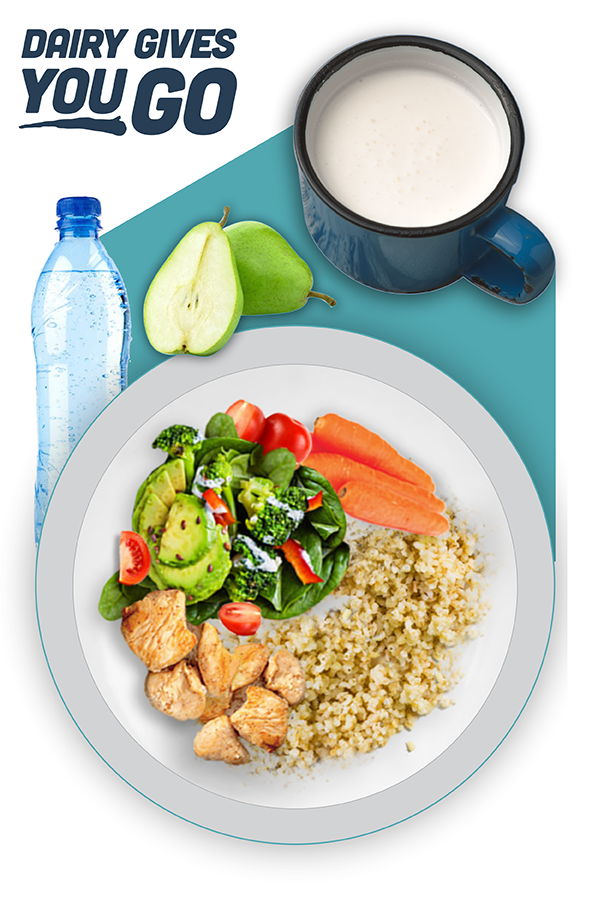
We should all try to eat a diverse, balanced diet. This means including foods from two or three different food groups in every meal in the right proportions and using different cooking methods. Having at least three mixed meals per day is ideal. To stay healthy, our diet should include enough water, macronutrients (protein, carbohydrates and fats) and micronutrients (vitamins and minerals). |
||
| Be active!
Physical activity is an important part of keeping healthy. It helps to build a strong body, keeps our hearts healthy and our body weight in check, and helps us to manage stress. Combined with a healthy diet, physical activity helps to lower the risk of many lifestyle diseases. |
||
| Make starchy food part of most meals.
Starchy foods are rich in carbohydrates and are good sources of energy. It is best to eat starchy foods that are unrefined or minimally processed, such as whole grains, cereal, potatoes and sweet potatoes. These foods provide sustained energy and also contain important micronutrients and fibre, which are important for adequate nutrition and good digestion. |
||
| Eat plenty of vegetables and fruit every day.
Fruit and vegetables are rich in micronutrients and other bioactive compounds. They are also an important source of dietary fibre. Eating fruit and vegetables helps to build a healthy immune system and supports good digestion. Choosing fruit and vegetables of different colours and type, and which are in season, will provide a good mix of micronutrients at affordable prices. |
||
| Eat dry beans, split peas, lentils and soya regularly.
Dry beans, split peas and lentils are referred to as pulses. They form part of the legumes group. These foods are inexpensive sources of plant protein, rich in dietary fibre, generally low in fat and also contain several minerals and vitamins. |
||
| Have milk, maas or yoghurt every day.
Milk contains nine important nutrients, including good-quality protein, minerals such as calcium, potassium, phosphorus, magnesium and zinc, and vitamins A, B12 and B2. Making dairy part of the daily diet can help to prevent nutrient deficiencies as it supplies three of the four nutrients generally lacking in the diet of South Africans (calcium, potassium and vitamin A). Fermented dairy products such as yoghurt and maas are good sources of probiotics, which help with good digestion. Milk and dairy are the best sources of dietary calcium, which is needed to build strong bones and healthy teeth. Having milk and dairy also helps to protect against lifestyle diseases such as overweight and obesity, type 2 diabetes, hypertension and cardiovascular diseases. The specific health benefits of milk and dairy stem from the unique way the nutrients work together in the food’s structure (a fluid in milk, semi-solid structure in yoghurt, and a solid structure in cheese). This combined effect of the nutrients in dairy is called the dairy matrix. The dairy matrix allows the nutrients in dairy to be easily absorbed, which helps to build a healthy body. In general, we should all have 2–3 servings of dairy per day to support good health. One serving of dairy equals 250 ml milk or amasi (1 cup), or 200 ml yoghurt (two small tubs). Including three servings of dairy per day in the diet makes it easy to reach the daily calcium requirement of 1 000 mg. Because most of our bone mass is built up during adolescence, teenagers need about 1200 mg of calcium per day. Having about 3 ̶ 4 servings of dairy per day can help teenagers meet their calcium requirements. |
||
| Fish, chicken, lean meat or eggs can be eaten daily.
Animal-derived foods are rich sources of good-quality protein, which is needed for growth, tissue repair and building strong muscles. Fish, chicken and lean meat are also rich in iron and many other vitamins and minerals such as vitamin B6, B 12. For good health it is best to choose lean cuts of meat, cut away visible fat on meat, and use grilling or baking as cooking method. Eggs, peanut butter and cheese also form part of this group and can be used as an alternative to meat. |
||
| Drink lots of clean, safe water
Water is essential for proper hydration. The body uses water to dissolve and transport nutrients and waste products, keep cool and keep cells functioning well. Although we get some water from foods and other beverages, pure water should still be our preferred drink. An average daily intake of 2–2.5 litres (8–10 glasses of 250 ml each) is recommended for everyone who is 8 years or older. |
||
| Use fats sparingly. Choose vegetable oils, rather than hard fats.
Dietary fats are not only a source of energy but also supply important fatty acids, which help with brain development and heart health. However, it is important to be aware of the amount and type of fat you consume. It is best to limit the amount of fat to 4–6 teaspoons per day, which includes oil used for frying or cooking and spreads such as margarine or butter on sandwiches. Vegetable oils from nuts, seeds and avocados contain unsaturated fats, which makes them healthier than fats from animal products. Remember that there are many hidden fats in biscuits and processed meats! |
||
| Use sugar and foods and drinks high in sugar sparingly.
This guideline tells us to limit the amount of sugary snacks and sugar-sweetened beverages in our diet. Sugary foods provide lots of energy, but very few other nutrients; these are also referred to as empty-energy foods. Too much sugar in in the diet can increase the risk of overweight and obesity, promote type 2 diabetes and cause dental caries. Limit your intake of added sugar to only 5% of your daily energy intake. This works out to 6–9 teaspoons per day and includes the sugar found in sweets, chocolates, biscuits, sauces, breakfast cereals and desserts. |
||
| Use salt and food high in salt sparingly.
The body needs salt, but only in small amounts. Salt (sodium chloride) is used to preserve food and processed foods, such as soup or gravy powders, stock cubes, potato chips, processed meats, cereals and ready-made meals, usually contain a high amount of salt. Ideally your daily salt intake should not exceed 6 g (1 teaspoon) or 1 500 mg sodium. Excessive salt intake may lead to high blood pressure and subsequent heart disease. |
2.2 Recommended number of servings
The South African FBDGs have been developed specifically for the local context. Remember that national health authorities do not use a food pyramid as the basis for nutrition messages, but rather group foods with similar functions and nutrient content together in the FBDGs, as described below. The following daily intakes are recommended for good health among young adults:
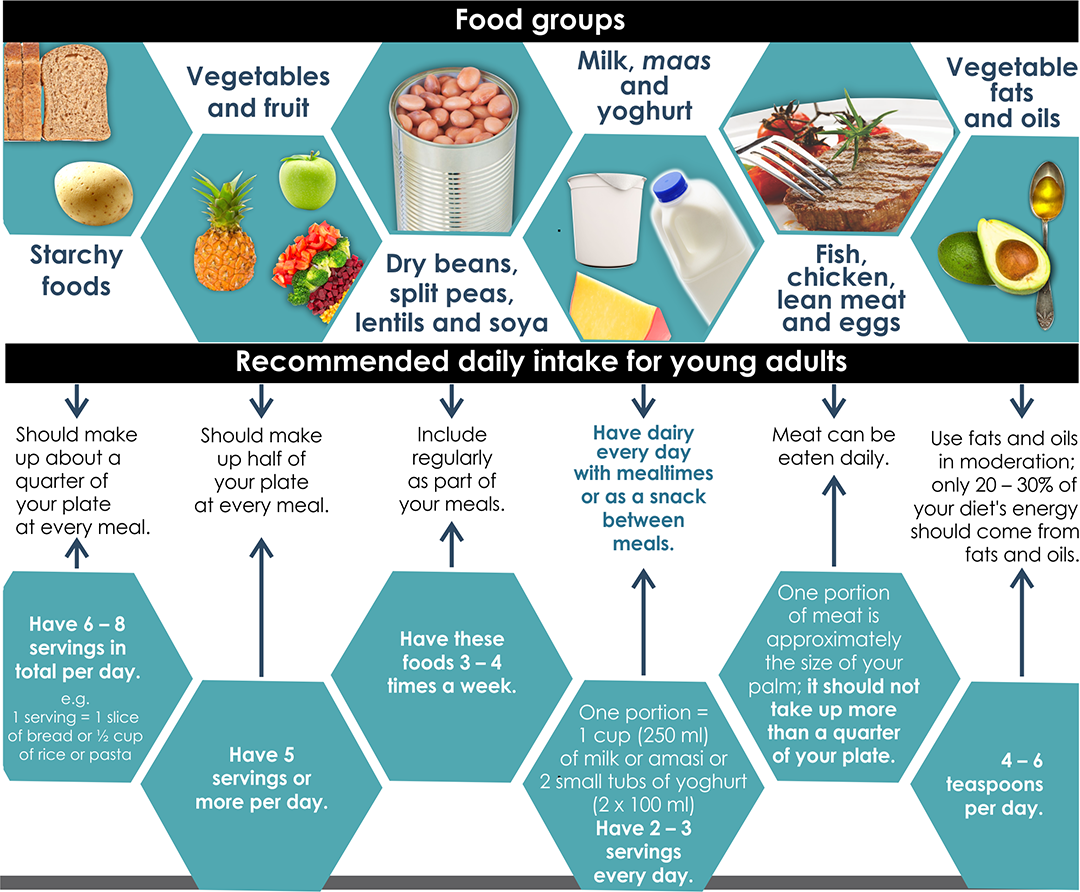

2.3 Glossary
lifestyle diseases: diseases that develop as a result of how we live and our behaviour, rather than being caused by an infection
nutrients: substances in food used to build, maintain and repair the body
balanced diet: a diet that includes a variety of different foods to give the body everything it needs to stay healthy
macronutrients: nutrients that the body needs in large amounts, namely carbohydrates, protein and fat
micronutrients: nutrients that the body needs in small amounts, namely vitamins and minerals
probiotics: friendly bacteria that help to keep the digestive system healthy
dairy matrix: the specific structure of dairy foods that allows the nutrients to work together in a beneficial way
unsaturated fats: fats with a chemical structure that keeps them loosely packed and flexible, rather than having rigid structure
3. Nutrients and their functions
3.1 Introduction
Food provides the body with nutrients. Nutrients are the building blocks that build, maintain and repair your body. The nutrients in food are classified as macronutrients or micronutrients.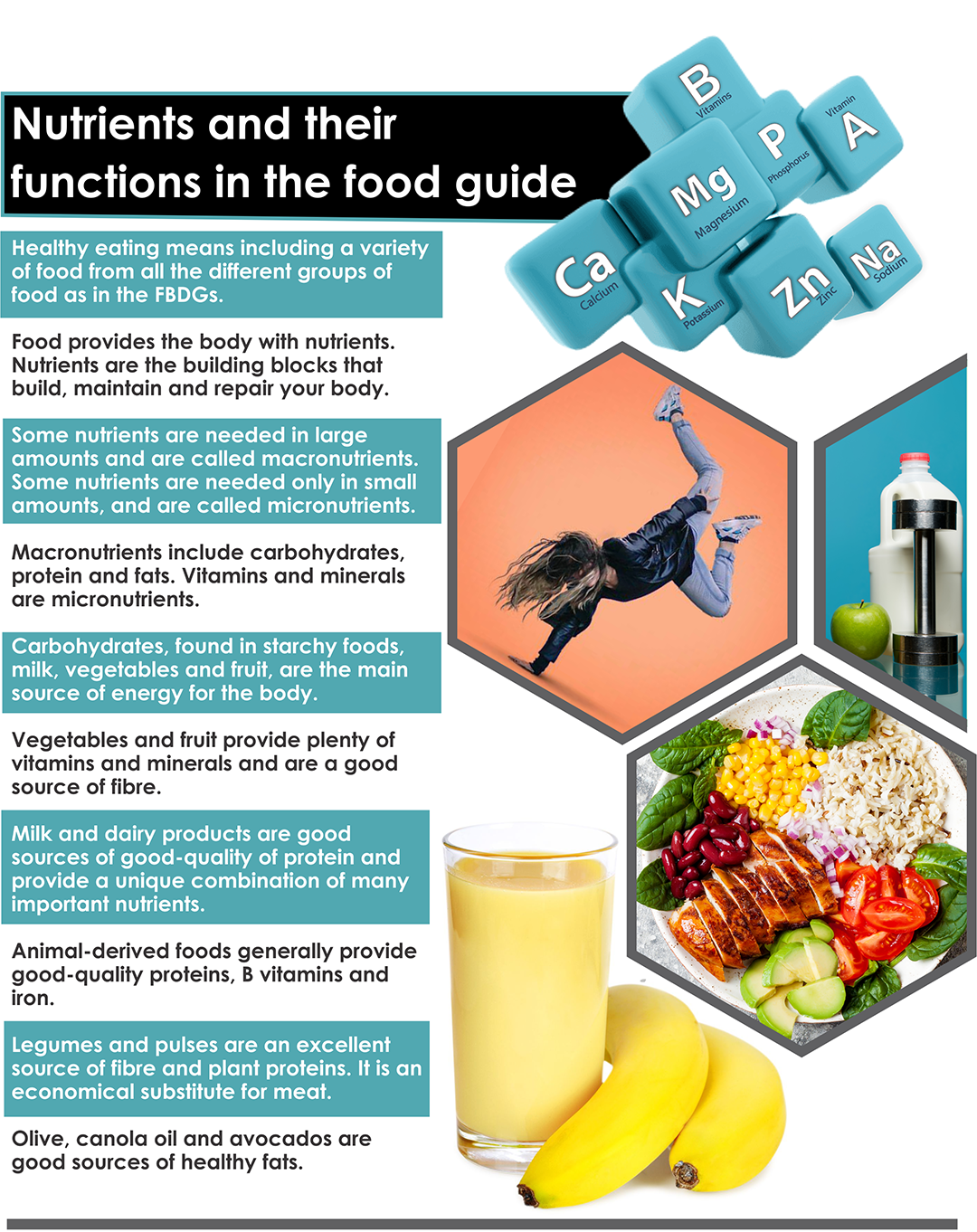
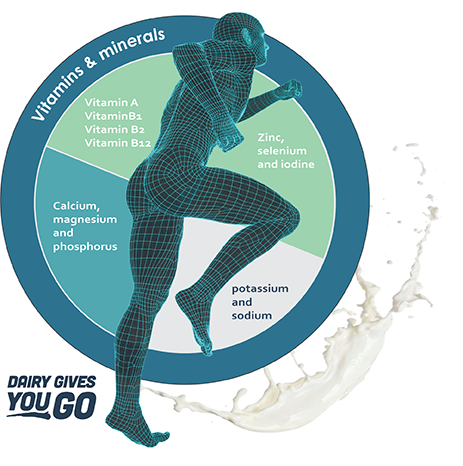
3.2 Macronutrients
These are the nutrients that the body needs in large amounts. There are three types of macronutrients, namely carbohydrates, proteins and fat. Each of these groups has unique properties to help keep the body healthy and provide energy (kilojoules).
3.3 Micronutrients
These are nutrients that the body needs in small amounts. Vitamins and minerals are micronutrients. Micronutrients are cofactors in metabolic functions, which means that they support the function of macronutrients. Some vitamins are fat soluble, namely, vitamins A, D, E and K, Vitamins B1, B2, B3, B6, B9, B12 and vitamin C are water-soluble. Important minerals include calcium, iron, potassium, sodium, zinc and phosphorus. Other important nutrients are fibre and omega-3 fatty acids.
3.4 Every food has a job
The South African food-based dietary guidelines group different foods together and recommend how often these should be included in the daily diet. It is important to eat a balanced diet consisting of a variety of foods to ensure that you get all the nutrients your body needs in the right proportions. (You can read more about the South African food-based dietary guidelines in 10.2.)
3.4.1 Starchy foods
Starchy foods provide mostly carbohydrates. Carbohydrates are used as the main source of energy for your body. They are the fuel for everything you do: from breathing and keeping your heart beating to playing sports and writing notes in your workbook. Energy also preserves muscle mass during exercise and provides fuel for the central nervous system and your brain. A person of average build and activity levels should consume 50–60% of their total daily energy requirements from carbohydrates.
In South Africa, bread and maize meals are staple foods and are generally enriched with vitamins and minerals to ensure optimal health. Starchy foods are also naturally rich in various B vitamins. For example, potatoes are a good source of vitamin C and vitamin B6. Vitamin B6 is essential for brain development during pregnancy and infancy, and contributes to more than 100 enzyme reactions during metabolism and helps the body to:
- make antibodies, which are needed to fight many diseases
- maintain normal nerve function
- make haemoglobin, which allows red blood cells to carry oxygen to body tissues
- break down proteins
- keeping blood sugar (glucose) levels within normal ranges.
Orange-flesh sweet potatoes – a starchy food – are a good source of beta-carotene. Beta-carotene is the precursor of vitamin A, which means it is converted to vitamin A in the body
It is best to choose wholegrain starchy foods, such as wholegrain or multigrain bread, oats, high-fibre breakfast cereal, brown or wild rice, and potatoes or sweet potatoes with their skin on. Apart from providing carbohydrates, these foods are also good sources of fibre. Insoluble fibre, such as in wholegrains and potatoes with their skin, helps to keep your gut healthy and makes you feel full. Soluble fibre, such as found in oats, helps to maintain healthy cholesterol and blood sugar levels.
3.4.2 Vegetables and fruit
Vegetables and fruit are good sources of many micronutrients, and specifically vitamin C. You can get plenty of vitamin C from eating citrus fruit (e.g. oranges, lemons and nartjie, tomatoes, red and green peppers, strawberries, guavas, kiwi fruit and spanspek. Vegetables and fruit may lose some of their vitamin C if they are stored or cooked for too long. Steaming and microwaving reduce vitamin losses and so are better than cooking vegetables in lots of water.
Green leafy vegetables, as well as yellow and dark-orange vegetables, are excellent sources of beta-carotene, which is the precursor of vitamin A. Vitamin A is good for the development of the eyes and is also an important antioxidant, which helps to repair cells and wards off infection. Most South Africans consume too little vitamin A and the government has a mandatory vitamin A supplement programme for babies and young children visiting government clinics.
Bananas and oranges are good sources of the mineral potassium, which helps to build a healthy nervous system and to control blood pressure. Fruit and vegetables are also good sources of fibre.
3.4.3 Milk and dairy
Cow’s milk provides both macronutrients and micronutrients. The dairy matrix, which refers to the unique combination of nutrients and biofactors in milk and dairy and how they interact with one another, highlights the overall effect of dairy on good health. The nutrients in milk and dairy are easily absorbed and readily available for use by the body.
Milk is an excellent source of high-quality protein, which have important functions in the body. It is crucial for proper growth and development and to build and repair body tissue. Protein also provides the amino acids (building blocks) used to make enzymes, which regulate metabolic functions, hormone function and the pH balance of your body. The protein in dairy is ‘complete’, which means it contains all the essential amino acids needed by your body. Milk protein also supports the function of the gut and may indirectly contribute to weight management because it makes you feel fuller for longer and helps to maintain healthy blood sugar levels. One glass (250 ml) of cow’s milk contains about 8 g of protein.
Cow’s milk also provides important micronutrients.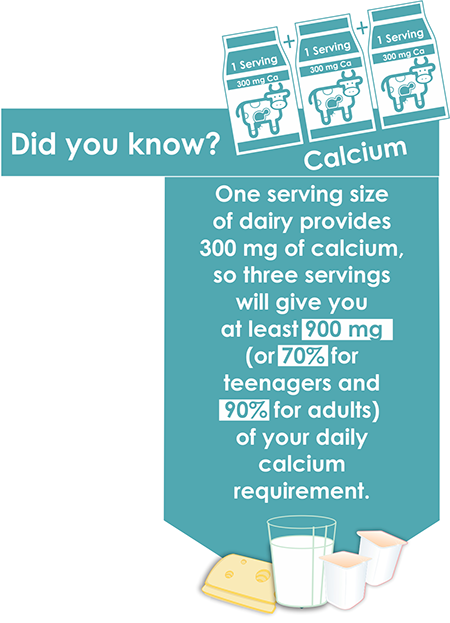 It is the richest dietary source of the mineral calcium. Calcium is critical for building and maintaining strong bones and teeth. The body also uses calcium for muscle contraction and to support nerve function. One glass (250 ml) of milk provides you with about a third of the recommended daily amount of calcium (300 mg) in a form that is easily absorbed by the body.
It is the richest dietary source of the mineral calcium. Calcium is critical for building and maintaining strong bones and teeth. The body also uses calcium for muscle contraction and to support nerve function. One glass (250 ml) of milk provides you with about a third of the recommended daily amount of calcium (300 mg) in a form that is easily absorbed by the body.
Other micronutrients in milk include vitamins A, B2 and B12, magnesium, potassium, zinc and phosphorus. Vitamin A is vital for the development of sight and specificaly night vision. It is also important to ensure a healthy pregnancy and during breastfeeding. Vitamin B12 helps to maintain a healthy brain and nervous system. Phosphorus supports calcium absorption, and also works with calcium in building strong bones and teeth. It also has an important role in how the body uses carbohydrates and fats.
3.4.4 Fish, meat, chicken, eggs, legumes and pulses
These foods are all sources of protein. Meat, chicken, fish and eggs provide complete protein, because they contain all the essential amino acids the body needs. Legumes, pulses, nuts and seeds provide many important amino acids, but not all the essential ones. Plant protein is therefore not a complete protein. Plant-based sources of protein also generally provide less protein per volume than animal sources of protein.
Foods in this category are also good sources of several B vitamins, vitamin E, iron, zinc, magnesium and soluble fibre. Vitamin B1 (also called thiamine), B2 (also called riboflavin) and vitamin B3 (also called niacin) act as co-factors (support) in the body’s energy metabolism. It plays a vital role in maintaining the body’s energy supply. This group of food is also the main source of good quality haem-iron. Iron is an essential element for blood production. About 70 percent of your body’s iron is found in the red blood cells of your blood called haemoglobin and in muscle cells called myoglobin. Haemoglobin is essential for transferring oxygen in your blood from the lungs to the tissues.
Adequate intake of zinc is important for a healthy immune system, wound healing, bone formation and brain development. Fatty fish such as sardines and pilchards are good sources of omega-3 fatty acids, which contribute to a healthy heart and good brain function.
3.4.5 Fats and oils
Fats are responsible for storing energy and protecting your vital organs. They also provide insulation to control body temperature and transport fat-soluble vitamins. At least 25–35% of your total daily energy intake should come from fat, but less than 10% should be from saturated fat. Saturated fat is found in coconut and palm kernel oil, shortening and animal fats. All natural fats and oils contain some vitamin E, which is an antioxidant, and omega-3 and omega-6 fatty acids. Fats also keep you in a good mood as it is a key ingredient of hormones in your body. Hormones such as serotonin and dopamine are involved in determining your mood.
Olive or canola oil, nuts, seeds, avocadoes and fatty fish such as sardines and pilchards are good sources of healthy fats. Full-cream milk is also a source of healthy fats. It contains more than 400 different types of fatty acids, which, together with vitamin B12, are important for brain development, and vitamin A. Vitamin A is essential for the development of the eye and healthy eyesight.
3.5 Typical plate examples
For a healthy, balanced meal:
- vegetables and fruit should make up half (50%) of a plate of food
- starchy foods should make up a quarter (25%) of the plate
- a protein-rich food such as meat, chicken, eggs or milk and dairy should make up the remaining quarter (25%).
Remember to include a variety of foods in a meal. You can do this by including at least two or three different foods from the different food guidelines (food groups such as starchy foods, vegetables and fruit, milk and dairy and meat). Here are some ideas for healthy, balanced meals:
- For breakfast, add milk or amasi to your cereal or porridge.
- Mix yoghurt with fresh fruit to make a delicious smoothie as a grab-and-go meal.
- For lunch, enjoy a sandwich with cheese or peanut butter and add a glass of milk to the meal.
- Add grated cheese to scrambled eggs on toast.
- Add amasi to a curry for a creamy taste and serve it on a bed of rice and a mixed salad.
- A thick cheese sauce is delicious with broccoli or mixed vegetables served with chicken and potatoes.
Did you know?
The average adult’s weight is made up of about two per cent calcium. Most of this is found in the skeleton and teeth (99%)– the rest is stored in the tissues or blood (1%). Calcium is vital for healthy teeth and bones. It also plays a crucial role in other systems of the body, such as the health and functioning of nerves and muscle tissue.
3.6 Glossary
amasi: a nutrient-rich, fermented dairy product, which is traditionally popular in South African
protein: a macronutrient essential for growth and repair in human cells
cow’s milk allergy: an undue immune response to milk proteins
lactose intolerance: the inability to digest the natural sugar found in milk
carbohydrates: macronutrients from food, which the body uses as its main source of energy
rehydrate: to restore lost body fluids and electrolytes during or after exercise
4. Food spoilage, safety and storage
4.1 Introduction
Micro-organisms in food can contaminate food, causing it to spoil or make us ill. Processing food and handling it hygienically are important to keep food safe for our use.
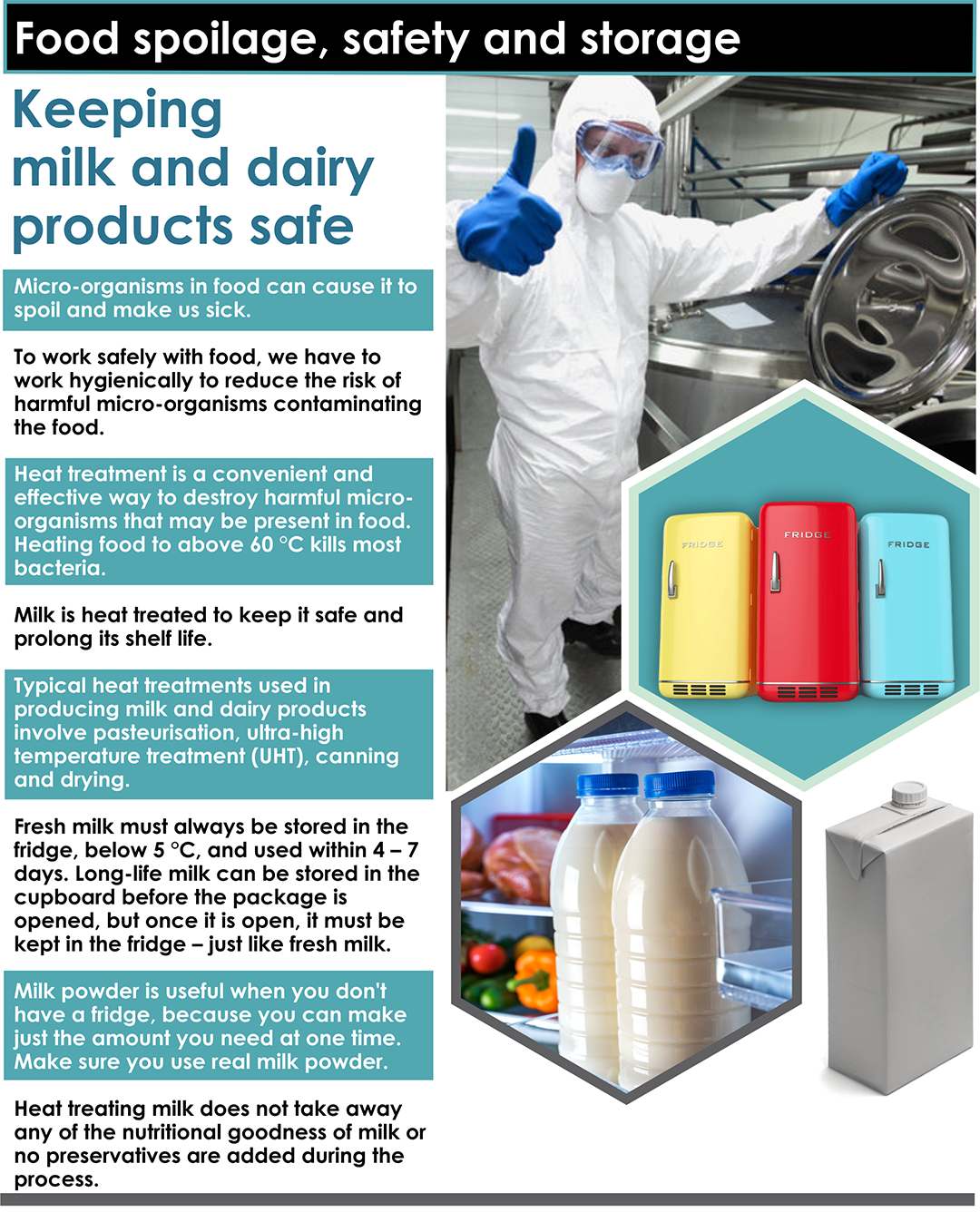
4.2 Food spoilage and micro-organisms: Safe milk
Many kinds of micro-organisms, such as bacteria and fungi (moulds and yeast), are present in the environment around us and can come into contact with food. For example, if people milking cows are not working hygienically or the area where milking takes place or the milk is stored is not regularly sanitised, micro-organisms can contaminate the milk.
When cows are milked, the milking equipment and milking area have to be cleaned and sanitised before and after each milking. People working in the milking area also have to be sure that they work hygienically to prevent contamination.
Some micro-organisms are pathogenic. This means they can cause disease. People can be protected from becoming sick by washing fresh fruit and vegetables before eating or by using heat treatment such as cooking or boiling to destroy micro-organisms.
Microorganisms are sensitive to heat, so heat treatment is a good way to keep food safe from contamination. Milk and fruit juices typically undergo a heating process called pasteurisation to keep them free of contaminating micro-organisms.
4.3 Food safety
Food safety means handling, preparing and storing food in a way that limits the risk of consumers becoming sick from food-borne disease.
The areas where we prepare food need to be cleaned and any leftover food should be removed from surfaces and utensils to prevent the spread of micro-organisms. In public places such as restaurants and take-away food outlets, it is especially important to clean and sanitise the food preparation area, because food that has been prepared earlier, may be eaten only later. If food stands outside too long, micro-organisms can grow rapidly.
4.3.1 Basic rules for food and kitchen hygiene
There are a few basic things to remember to ensure that we work safely when preparing food:
- Wash your hands regularly with soap and water. If possible, also sanitise before working with food.
- Keep surfaces and utensils clean by washing or sanitising them thoroughly before and after working with food. Micro-organisms can hide on dirty surfaces and contaminate food.
- Always separate raw and cooked food. Bacteria can pass from raw food onto the hands of a food handler, and then be transferred to the work surfaces, equipment or the served food. Never put cooked food in containers that carried raw food.
- Store food below 5 °C or above 60 °C. Micro-organisms can grow easily between 5 °C and 60 °C, which makes this range a temperature danger zone.
- Cook food thoroughly. Micro-organisms are heat sensitive, so proper cooking kills almost all micro-organisms.
- Have good personal hygiene. Always wear clean uniforms, aprons or clothes, keep your fingernails short and wear a hairnet, and do not touch your mouth, hair, face or skin when working with food. If you do, always wash your hands afterwards.
4.3.2 Heat treatment to keep food safe
Heating food to above 60 °C will generally destroy any bacteria present in the product, especially those that make us sick.
4.3.3 Heat treatment of milk
Pasteurising milk involves heating it to 72 °C for 15 seconds and then quickly cooling it to 4 °C. This process kills any harmful bacteria that might be present in milk and stops any other micro-organisms from growing.
Raw milk should always be heat treated before use. A process similar to industrial pasteurisation can be done at home by placing milk in a clean pot and heating the milk until small bubbles appear along the sides. Do not let the milk boil. When you see bubbles forming on the side of the pot, remove it from the heat and let the milk cool down. Keep the pot covered with the lid. Then store the milk in clean, dry containers in the fridge. This process ensures that the milk is then safe to drink.
4.3.4 Other types of heat treatment
The process of pasteurising milk has been refined over the years to make the process more efficient. These treatments involve different heat intensities and treatment times.
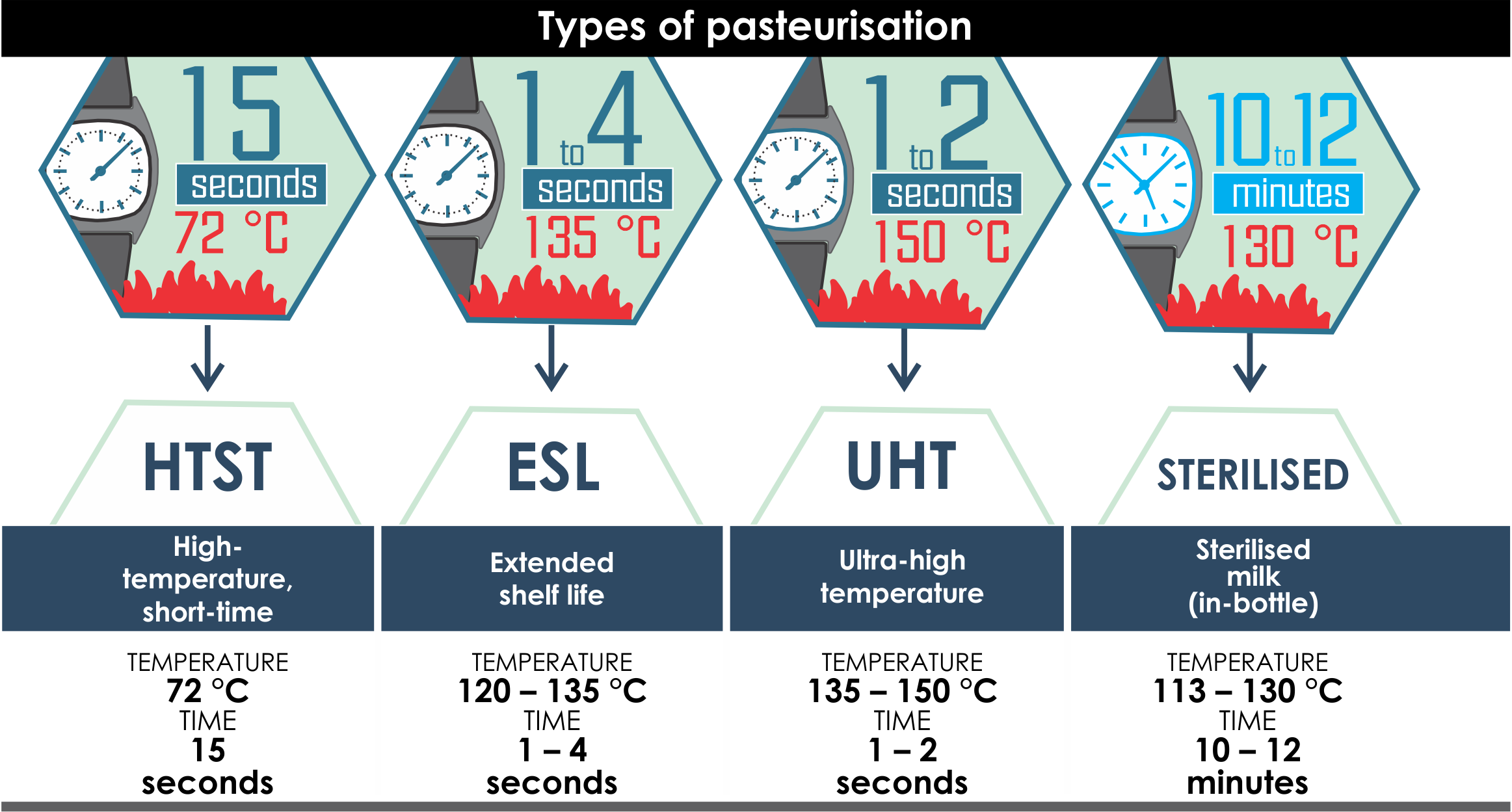
4.3.4.1 Ultra-high temperature treatment
Ultra-high temperature (UHT) treatment is a version of pasteurisation that uses very high temperatures (135–150 °C) for a very short time (1–2 seconds). This effectively kills all micro-organisms that may be present in milk. The milk is then cooled before being packaged aseptically. This process allows milk to be stored in closed containers at room temperature if left unopened. This treatment is used to produce long-life milk. Remember that heat treatment does not change the nutritional value of milk – long-life milk has the same nutritional goodness as fresh milk.
4.3.4.2 Sterilised milk
In-bottle sterilised milk is produced by passing bottles filled with milk along a conveyor belt through a steam chamber, where they are heated to 110–130 °C for about 25-35 minutes. The bottles are then cooled. Unopened bottles of sterile milk last for a long time without refrigeration. Once opened it must be kept in a fridge and used within five days.
4.3.4.3 Canning
Canning involves subjecting a food product to high heat in a container placed in a pressurised vessel. The product is heated to 125 °C for 21 minutes, which produces a sterile product ready for eating. This process is used to produce condensed milk and evaporated milk. The shelf life of canned products is much longer than that of fresh, minimally processed or pasteurised products.
4.3.4.4 Drying
Drying is a process whereby moisture is removed from a food product so that micro-organisms cannot grow. Milk powder is made in an industrial process by pumping fresh milk into a drying chamber to let the water evaporate. This leaves only the milk solids behind. Consumers can then simply mixed the powder with water to make liquid milk again.
Milk powder is just as wholesome as fresh milk. Using milk powder is convenient if you do not have a fridge or if you are going on a long trip. Milk powder is also used in product formulations such as porridge.
Remember that coffee creamer is not the same as milk powder! Coffee creamer is made from unhealthy plant fats and does not contain any of the nutrients found in milk.
4.3.4.5 Storing heat-treated milk
Once fresh milk has been pasteurised, it has to be stored below 5 °C to keep it safe. At this temperature, micro-organisms cannot grow easily, so keeping milk refrigerated will prevent it from spoiling easily. Long-life milk can be stored at room temperature before being opened, but once opened it has to be refrigerated, just like fresh milk.
4.3.4.6 The cold chain for dairy products
The cold chain refers to a series of uninterrupted refrigerated steps during the supply process: from the farm to the factory, from the factory to the shops, and from the shops to the home. In the cold chain, food is kept refrigerated throughout to prevent it from spoiling.
The cold chain is important in producing dairy products. After the cows have been milked, the milk is collected from the farm in a refrigerated tanker, which transports it to the processing plant at a temperature below 5 °C. Here the milk is pasteurised and bottled or used to make other dairy products. Finished products are stored in clean containers or packages and refrigerated. From here, the products are again transported in a refrigerated truck to shops. At the shop, fresh milk and dairy products are stored in fridges. At home we put the fresh milk and dairy products in the fridge.
4.4 Glossary
contaminate: to spoil or infect something such as food or water
food-borne disease: illness caused by harmful bacteria in food, such as food poisoning
pasteurisation: a process in which a food product is heated to a high temperature for a short while to destroy harmful bacteria
pathogenic: causing disease
aseptic: free from contamination by micro-organisms
5. Practical Activity – Basic White Sauce




